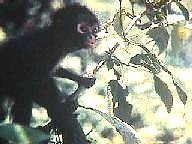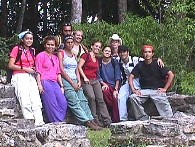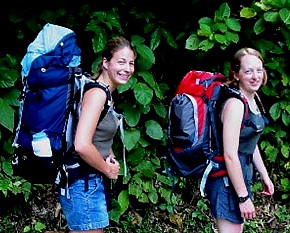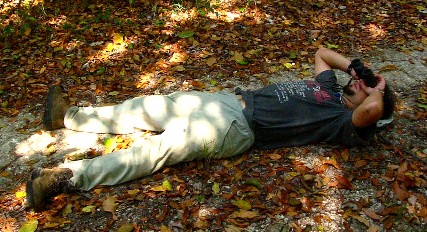Primatology training: Internships and Field Expeditions 2003


Laboratory of Primatology
(esta hoja estará disponible en breve en Español)

Primatology training: Internships and Field Expeditions 2003
|
Laboratory of Primatology (esta hoja estará disponible en breve en Español) |
 |
|
Petra Wilbrink, Yasminda García del Valle, Joe Hawes, Sarie Van Belle, Seledonio (our field guide) and Manuel Oñorbe in the rain forests of the Biosphere Reserve of Montes Azules in Chiapas, Mexico, close to the Guatemalan border. |
The
Laboratory of Primatology is host every year to students
from Mexican and foreign universities that participate in
on-going research projects as part of academic
internships that may last from 1 to 12 months. Students
form part of field teams that assist in the census of
wild populations of howler and spider monkeys in Los
Tuxtlas and at other sites in southern Mexico. They also
contribute to the development of field projects on the
behavior and ecology of selected primate populations,
including the gathering of contextual information such as
habitat quality and state of conservation, geographic
information, as well as collecting of biological material
relevant to field projects. The projects in which these
students participate are described in the main pages of
this web site. These mainly deal with work with primates,
but also with other mammals such as bats as well as birds
and with the investigation of ecological processes such
as the ecology of seed dispersal by mammals and its
impact in rain forest regeneration. During 2003 the following students are participating in academic internships: Sarie Van Belle (University of Ghent, Belgium), Pola Abaza (Free University of Berlin; Germany), Petra Wilbrink (Wagenigen University, The Netherlands), Joseph Hawes (Nottingham University, Great Britain), Manuel Oñorbe (Universidad Complutense de Madrid, Spain), They all have their undergraduate degrees and will be pursuing graduate studies shortly. The following images were taken during our month-long last expedition to various sites south of Los Tuxtlas (see map in main page on primates) where, along with Mexican students, interns assisted in censusing primate populations and in collecting fecal samples for studies of DNA and parasite loads. |
 |
During 2003
the following students are participating in academic
internships: Sarie Van Belle (University of Ghent,
Belgium), Pola Abaza (Free University of Berlin;
Germany), Petra Wilbrink (Wagenigen University, The
Netherlands), Joseph Hawes (Nottingham University, UK),
Manuel Oñorbe (Universidad Complutense de Madrid,
Spain), Katie Beranek (Notre Dame University, USA), Liz
Shaw (Bristol University, UK). They all have their
undergraduate degrees and will be pursuing graduate
studies shortly. The following images were taken during
our month-long last expedition to various sites south of
Los Tuxtlas (see map in main page on primates) where,
along with Mexican students, interns assisted in
censusing primate populations and in collecting fecal
samples for studies of DNA and parasite loads. Katie Beranek and Liz Shaw on their way to work with a howler monkey population living in a cacao plantation. Behavioral observations and survey work are the main focus of research assisted by Katie and Liz. |
| Katie and Liz at the cacao plantation in southern Mexico observing and recording howler monkey behavior and collecting fecal samples for assessment of parasite load. |
Shelly Lachish, Biologist from Queensland, Australia assisting our research in southern Mexico, surveying wild primates and bat populations and assessing genetic parameters using non invasive techniques in populations of howler monkeys |
Shelly, Sarie, Liz, Katie and Joe posing with the research truck before leaving for the Yucatan peninsula to work with bats and spider monkeys |
Team on its way ! |
Expedition March-April 2003
| Itinerary followed by our research team in our month-long + expedition in March of 2003. We travelled about 4000 km of roads, worked in six sites (stopping over in Palenque, Chiapas # 3 in map), in the sequence indicated by the numbers in the map (1 = Comalcalco, Tabasco, 2 = El Tormento, Campeche, Montes 4 = Azules reserve, Chiapas, 5 = Calakmul, Campeche, 6 = Punta Lagunas, Yucatan, 7 = Celestum reserve, Campeche/Yucatan. At these sites primate populations were surveyed to obtain fecal samples for DNA extraction and parasite load studies, and conducted censuses of the primate populations. At the Celestum reserve (7), using mist nets, we censused the bat population in a naturally fragmented ecosystem (Petenes). In the Montes Azules reserve (4) we also conducted a 30 km long river survey (Lacantum River) of primate populations. |
| Lacantum river in southern Chiapas, about 10-20 km from the border with Guatemala. The forest in the background is the Montes Azules biosphere reserve (Lacandon forest). |
Manuel Oñorbe |
Sarie Van Belle and Joe Hawes georeferencing a study site using a GPS and compass |
Joe Hawes interacting with a female coati (Nasua narica) in the rain forests of southern Mexico |
Sarie Van Belle, Petra Wilbrink and Yasminda García del Valle |
In search of primates in the rain forests of Campeche |
 The "horizontal" technique developed by Manuel Oñorbe to study howler and spider monkeys |
Surveys of primates by interns involves difficult crossings...the majority make it across!
Manuel Oñorbe and Petra Wilbrink |
Sarie Van Belle |
Yasminda García del Valle |
A poor imitation of a howler monkey climbing skills by Manuel Oñorbe! |
Sarie Van Belle always happy when collecting monkey fecal samples! |
Joe Hawes dry dock adventures in the Montes Azules reserve, waiting for the river to rise! |
In search of primates in Rio Lacantún, Chiapas (Joe looks happier!) |
In most of the sites investigated we have the assistance of local people as field guides. These people are extremly knowledgable about the rain forest and the relationship we mantain with them as the work is carried out is an important linkage of our field research with the local inhabitants.
Domingo, our field guide in Los Tuxtlas |
Seledonio (left), our field guide in the Montes Azules biosphere reserve in Chiapas (here, navigating the Lacantum river with our team in search of primates). |
Our youngest field guide a Mayan boy, 10 years old, with an extremly high knowledge of spider monkey behavior and of rain forest trees. |
| Contribute to the conservation of tropical rain forests | Protect the primates of southern Mexico |